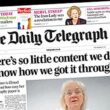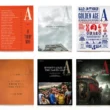It is almost 200 years since the UK’s pioneering railway network created the opportunity for daily newspapers to reach breakfast tables in every corner of the country. That led to decades of soaring power, prestige and profits. The newspapers of “Fleet Street” (named after their historic location) became as important to Brits as Shakespeare, the BBC and the ruling Monarchy. So, there’s good reason to start in London when trying to predict the future role of traditional news brands. But it’s not a pretty picture.
The nine national daily newspapers had an aggregate circulation of 6.5m copies in August 2015 – 35% down since 2010. Advertising revenue too has plummeted, and is still falling.
Since the UK’s 2008 recession, newspapers have tried to compensate for the lack of advertising by increasing cover prices, despite having fewer pages. The Guardian, for example, has seen its circulation drop by 50% since 2005, but its cover price has more than tripled – from 55p to £1.80. All the broadsheets have at least doubled their cover prices and have generally lost more copy sales than the tabloids. But all the revenue is still going backwards.
It is widely acknowledged that the under 34-year-old “millennials” have all but abandoned print. But so have many others. The circulation of The Sun (which has the largest number of millennial readers) has fallen by 43% since 2010. But so too has the broadsheet Daily Telegraph, whose readers average 61 years of age.
This year’s Reuters Institute Digital News Report (across 12 countries including the UK, US, Australia, Japan, and Germany) said that, although only 4% of 18-34 year olds regarded print as their main source of news, it was still only 12% for people over 55. Reuters reported that, in every country, print was ranked either third or fourth as “the best source for news accuracy”, behind TV, online and social media. And, in the UK, print only scored 7% as the most trusted for news.
Growing numbers of young and not-so-young people get their news from social media. And some newspapers find that even older readers are tending to scan their online content in “first paragraph reading”. The trend is fuelling the demand for email newsletters from news companies new and old. Increasingly, it is not just the BuzzFeed generation which wants quick-fire news. That’s the uncomfortable truth for news brands which have believed that their depth of content would secure the future. Some people will always want long-form journalism and in-depth reading, but it’s a shrinking market.
Their challenge now is to create digital services which can satisfy the changed appetite for news, while maximising their profits from print. But newspapers’ whole sense of the future has been disrupted by the way that plunging print sales have necessitated sharply increased cover prices, which have fed through to further circulation decline. In the UK, as elsewhere, publishers have found it impossible to guess what will be left when the print music stops. The relatively large digital audiences are not much comfort because it is still print that makes the profit. Even now, it can generate levels of advertising revenue seemingly unobtainable in digital media.
Digital is so different
Monetizing digital audiences is, therefore, as problematic as stabilising print. But that, according to Clark Gilbert, is where the similarity ends. His ground-breaking stewardship of Deseret Media proved that separating traditional media from digital really can achieve his much-vaunted “double transformation”. In his Salt Lake City real-time case study, the former Harvard professor turned round Deseret’s traditional media while building a world-class digital group – in parallel. The two businesses are managed completely separately – and are also a few miles apart. But media companies need not go quite that far to surmount the obstacles to digital success that Gilbert identified.
He asserts that there are two distinct objectives for most traditional media: 1. To slow or reverse the decline in print profits; and 2. To build a future-proofed “new” business that is able to compete on equal terms with digital-only companies. By maximising the profits of traditional media, the parent company can invest more strongly in digital. Both management teams can be focused on their respective objectives and not distracted by each other, even though they may share much of the core content.
More than anything else, the strategy requires separation of general management, beyond anything that is currently happening in UK national newspapers. And that’s before you consider that these two distinct businesses will increasingly require quite different types of people. The fact is that, despite some digital successes, many traditional news groups are obstructing their own future development by choosing not to compete with their own newspapers – unlike digital-only companies which can have no such qualms. This translates into uncompetitive digital strategies, characterised by:
- Web sites that are often a clone of the newspaper in content, design and functionality
- Paywalls, even for increasingly-commoditised general news
- Bundled ‘no choice’ print+digital subscriptions
- Advertising sold jointly across print and digital media
For all their relatively high traffic, these newspaper sites are dependant on print and – even when staffing costs are allocated internally – the digital operations often have higher costs than their competitors. And the more that newspaper revenues fall, the tougher it will get to create a successful business model for combined print-digital operations. These companies have, after all, some formidable competitors in digital news. Muscling in on the likes of Vice, BuzzFeed, Huffington Post, and Vox is much easier said than done.
The big hurdle for most newspapers is facing up to the reality (in digital and, increasingly, in print) of narrowing down to one primary revenue stream instead of two. In most cases, digital operators have moved the market to free content funded by advertising and sponsorship. And even traditional news brands seeking to retain subscribers will have to break with the traditions of their newspaper past and ‘unbundle’ the offering so that readers/users pay only for what they actually want. That is the future of paid-for digital services. Just ask US cable TV operators. The current rise of ad blockers is a reminder that advertiser-paid services too will have to do things very differently.
The news content of Facebook, LinkedIn, SnapChat and YouTube shows that – even if traditional brands push into these new channels – they cannot, to say the least, expect to match their traditional expectations of revenue. Which is another way of saying that traditional media companies have to align their skills, staffing, costs, and operating flexibility with those of their “new” digital competitors. Or else.
High-profit weekends
Nowhere is this dilemma clearer than in our estimates which show that UK national daily newspapers:
- Generate more than 75% of their total revenue (and more than 50% of circulation revenue) from their weekend editions
- Saturday is their most profitable day (by far), with larger circulations and c50% higher cover prices
- Most would be substantially more profitable if they published only at weekends or reduced their weekday frequency
So why are they not trying to maximise their profits by reducing the frequency? These weekend editions are actually quite different to those published by the same newspapers on weekdays. It’s more about magazine content than news. Take last week’s Sunday Times. The bulky £2.50 package comprised no fewer than four separate magazines totalling more than 300 pages, in addition to the seven-section newspaper itself. The Daily Mail (whose Saturday circulation is some 50% higher than on weekdays) publishes a slew of high-quality magazines at the weekend. And they’re all playing the same game.
This is reinforced by the Financial Times’ weekend edition (cover price: £3) which includes a high-rated magazine, multiple sections on leisure, and not much about finance. But it sells nearly twice as many copies as the weekday edition (price: £2.50). And that is the point. These weekend performances spell out the same basic truth that comes loud and clear from digital audiences: people are increasingly reluctant to pay much (or anything at all) for news. Columnists, analysis and magazine content can be different.
That just might comfort hard-pressed magazine publishers on whose territory these weekend newspapers are increasingly trampling. More than anything, though, it suggests that – if daily papers do not start soon to take the hard decisions on reduced frequency – they will hasten their own demise. Saturday circulations are, after all, substantially larger than weekdays despite cover prices that are some 50% higher. And weekend advertising – including highly-profitable inserts from retailers – is relatively buoyant.
This tells newspapers that – IF they can maintain these weekend sales – they will become much more profitable by dropping at least some of their weekday print editions. And that is before you consider that the magazine-style content of these weekend editions might require proportionately fewer of the news journalists whose high-cost teams weigh down daily newspapers. Breaking the daily cycle is not without risk, of course, but newspapers must try and stabilise the core business. Perhaps some newspapers should publish only in and around weekends while others might publish 4-5 times a week.
The point is that every-day newspaper reading peaked during times when these famous news brands faced much less competition – for readers as well as advertisers. There is an inescapable need for reinvention of the business model: Price and frequency are the obvious levers. Inevitably, the transition to reduced print frequency would involve the promotion of tablet and digital editions of the ‘newspaper’.
Alternatively, there is a risk that the continuing decline in weekday revenues will drive yet more aggressive weekend pricing to the point where it will affect sales and undermine the profits. That’s how it is with market disruption: if you don’t make the change quickly, the opportunity will disappear. What the calculations show is that – quite apart from anything digital – these brands can can still generate long-term profit from print – if they sort out the costs.
The news last week that Quebec’s French-language newspaper La Presse is going digital-only on weekdays should get them thinking. The 131-year-old La Presse, which discontinued its Sunday edition in 2009, is a middle-market broadsheet and one of Montreal’s largest
newspapers. Its decision follows a determined campaign to increase digital advertising which now accounts for 70% of revenue. That’s what “Fleet Street” needs to imitate.
The Quebec switch to all-digital (except at weekends) comes two years after the The Times-Picayune in New Orleans reduced its print frequency to three times weekly, which is something that the publisher Advance (owner of Conde Nast) has implemented in other US regional markets. Significantly, there are rumours that the troubled New York Daily News is also planning to reduce print editions by at least one day per week. It’s a start.
Daily newspapers might usefully move to an intermediate business model in which the paper is still printed up to, say, five times weekly while subscribers are persuaded to pay for the print/online package. But – in order to future-proof the business – such a strategy would have to involve relatively low-price (or even free) subscriptions. And the digital service would have to develop some independence of print in content, design, functionality – and advertising sales.
But that all requires big change, job losses, rationalisation of print plants and real disruption. It all seems a bit unlikely from the current UK situation where – despite the never-ending story of falls in circulation and advertising revenue – most publishers seem either to be in panic or paralysis. While it is, therefore, very difficult to identify robust long-term strategies at London’s national dailies, things might just develop as follows:
Will Mail Online be sold?
Although the Daily Mail & General Trust (DMGT) is best known for the eponymous newspaper, its global B2B information business actually accounts for more than 75% of revenues. It’s really no longer a newspaper group at all. The strident mid-market Daily Mail remains one of the strongest UK dailies, but copy sales have declined by 40% since 2005. Some 50% of the £95m operating profit which DMGT now gets from print may now come from its Metro free tabloid – and not from its flagship paid-for newspapers.
The company also operates MailOnline, often described as “the world’s largest newspaper web site”. This is nicely misleading because, although the site includes all the content from the UK newspaper, its global audience has been built on digital-only celebrity coverage.
It was one of the first traditional news brands to gear its digital content to analytics and click-bait. Its web-only operations now include teams in Australia and the US (where it recently acquired the millennial-captivating Elite Daily). But it is still managed by the parent newspaper which might explain why – despite its 200m+ monthly uniques – it lags BuzzFeed in revenue, profit and the development of video content.
This was reinforced by the recent disclosure that MailOnline’s advertising growth has slowed to 16% (one-third of what it was a year ago) and that its annual revenue is now running at about £70m (maybe 40% behind BuzzFeed). For all the huge audience numbers, MailOnline is now less likely to be a long-term global winner. From the start, it may have concentrated too much on audience-building, assuming that advertising would naturally follow. But digital advertising depends on sponsored content and embedded native advertising not on the high-volume display ads beloved of newspapers. MailOnline has, to say the least, been no match for BuzzFeed, which has mastered the whole art of “news you can share”. While the Mail was mostly attracting users to its own site in a very traditional way, BuzzFeed content (which was made for sharing) was all over Facebook. As a result, the Mail is some way behind and so is its development of a viable business model. But there’s more.
MailOnline’s huge audience growth has, perversely, helped the newspaper’s long-time management preserve their bloated global team of 800+ journalists. This partly betrays a sentimental attachment to the heritage of a 100-year-old newspaper company and clearly hinders digital development. It may also, temporarily, disguise the asset values of a company which has frequently bought, sold and floated its individual media businesses. So, perhaps, we can guess what will come next.
It is reasonable to estimate the value of MailOnline as something like the £1bn ascribed recently to the powering BuzzFeed. This means that the Daily Mail’s online site may be worth at least 40% of the entire market capitalisation of the DMGT parent – which could be much more profitable without it. It may not be too long before the frustrations of print-shackled digital competition prompt irresistible plans for a high-priced divestment or IPO. Separation of the site from the Daily Mail would not be without its challenges, but money talks. The rumours of unsolicited bids for MailOnline have already begun.
Could The Sun catch BuzzFeed?
Among the things that may help DMGT decide to sell-off MailOnline are the emerging plans by News Corp UK. It is back under the leadership of Rebekah Brooks who has used some of her time away from News Corp (and the UK law courts) to develop strong views on how newspapers should transform themselves. Having been burned by early digital disasters like the acquisition of My Space, her boss Rupert Murdoch now supports major strategic changes at his core media company, which may include:
- The Sun (still Britain’s largest popular tabloid) which has partly dismantled its paywall, wants to become a global competitor for BuzzFeed – and MailOnline. The digital service would – increasingly – be managed separately from the newspaper. Significantly, Brooks’ first appointment since returning to News Corp is Tony Gallagher who becomes Editor of The Sun having switched from the Daily Mail. Expect some big change to the current ho-hum site.
- The Times/ Sunday Times are expected to spearhead the launch of a “new” global news brand in tandem with The Australian, New York Post and the Wall Street Journal. The smart money is on a freemium “super site” – to compete with The Guardian and, increasingly the Washington Post and the UK’s Daily Telegraph. Most content would be free but subscribers could access high-value video streaming including sports. It might slightly resemble Huffington Post, with content drawn from News Corp’s newspapers.
Who will buy the Daily Mirror?
For all the essential digital reassurance for stock-market investors, Trinity Mirror, publisher of the Daily Mirror and the largest collection of UK regional
newspapers, is proving to be best at maximising profit from the decline of print. The UK public company has been ramping up profits by squeezing the costs and establishing a track record that helped shareholders to be thrilled at its latest decision to buy Local World’s 100+ UK regional papers for a cool £200m. The painful truth of Trinity Mirror – formed as a merger 16 years ago of local news group Trinity International and the Daily Mirror – is that local papers may not really have much in common with national dailies – whether in print or digital.
Rebekah Brooks may already be wondering whether she can persuade Trinity Mirror (and the regulator, bit more tricky that) to let News Corp acquire its national dailies, not least to help turbo-charge her digital plans. A deal could suit both companies – and further reduce the fierce news competition that remains an obstacle to transformation.
It’s slightly less spectacular but, like DMGT without MailOnline, Trinity Mirror would become a stronger and more profitable market-leading business without the Daily Mirror. It would be able to concentrate its skills and resources on the potential growth of what will be more than 300 UK regional and hyper-local brands across print and digital. Regardless of who bought the national papers, Trinity Mirror wouldn’t have to compete with Rupert Murdoch.
Will the Telegraph do a deal?
The Telegraph Media Group is owned by the reclusive (and mostly non-media) David and Frederick Barclay. The Daily Telegraph’s strong news content, relatively successful marketing of print-digital subscriptions, and its quietly growing video resources, have given this 160-year-old news brand a growing digital audience. And it remains a highly profitable private company and the leader in e-commerce and ‘reader offers’. Will it secure a digital future with some kind of global alliance, say, with Australia’s troubled Fairfax Group, the Washington Post, or (at last) with Axel Springer (arguably the European digital leader among European news brands) which has long coveted it? A deal with Springer might even bring in the New York Times, with whom the German company has shared some digital deals.
An explosion of free newspapers?
In a country where free newspapers and magazines are competing strongly with paid-for media, it is logical to ask which of the UK national dailies will become free, alongside the Metro (generating some £40m operating profit), the London Evening Standard (£2m), and City AM (£250k). The expected fall of (most) news paywalls will signal a substantial expansion in free distribution. Here are some predictions:
- Richard Desmond’s still-profitable Daily Express (circulation: 430k) will revert to publishing free during the week, with paid-for publishing only at weekends. Or, perhaps, his Daily Star (400k) will simply go free all week instead?
- Evgeny Lebedev’s loss-making The Independent (whose sales have fallen sharply to less than 45k while its i newspaper sells 276k) will close or go free – alongside its thriving London Evening Standard
- The Guardian (139k weekday, 295k Saturday) will eventually succumb to free weekday distribution. After all, the print is fast becoming an ancillary activity to The Guardian’s free-access, fast-growing global online news. If weekday sales fall below 100k, the decision will make itself.
Powerful brands – still
The UK’s national daily newspapers are powerful brands which still command substantial audiences. That is reinforced by the fact that the country’s two TV news networks devote several hours a day to ‘reviewing’ their content. Their influence, therefore, belies the collapse in readership. In so many ways, these news brands are well placed for reinvention, but they will need to make some tough decisions both on print and digital. And these once mighty beasts of the news jungle might have to collaborate with other media in ways they would never have contemplated. After all, the inexorable growth in mobile and video is an urgent reminder that the competition for digital news is accelerating away from them.
If these famous British newspapers continue to operate as if history owes them a ticket to the future, they might as well start building museums. It’s been a fascinating history after all. But it really doesn’t have to end here.





another very insightful analysis.
agree that in a few years most print newspapers will be only once or twice a week
a six or even 7 day print product makes on sense